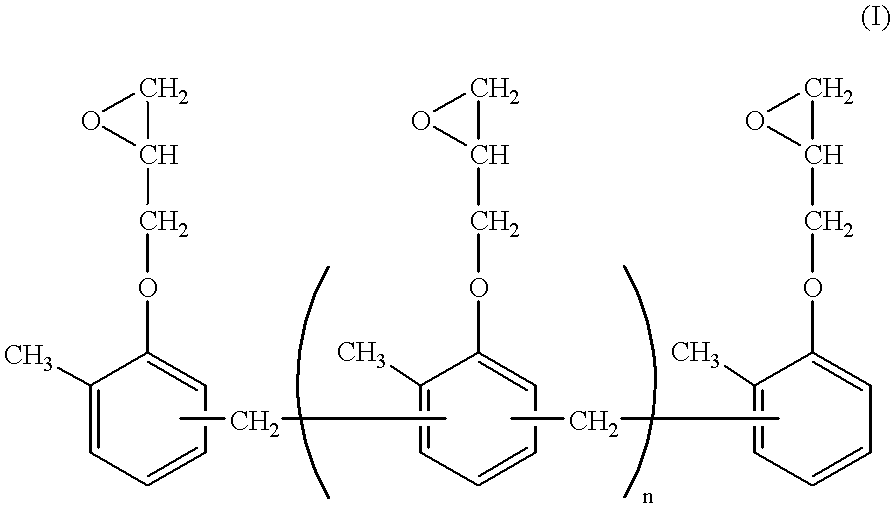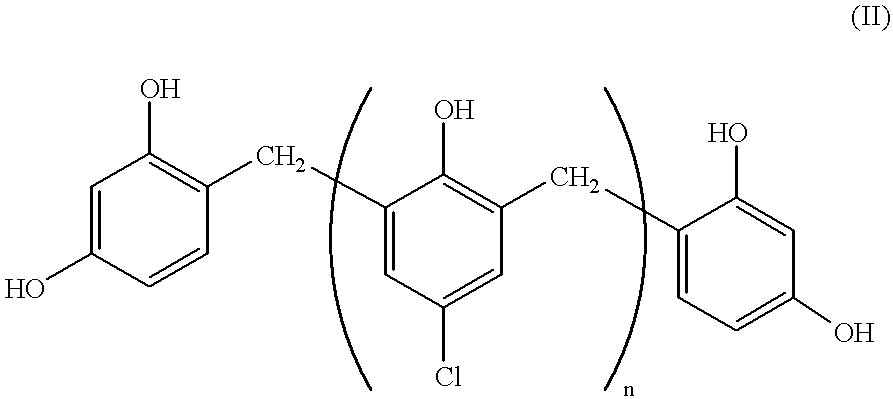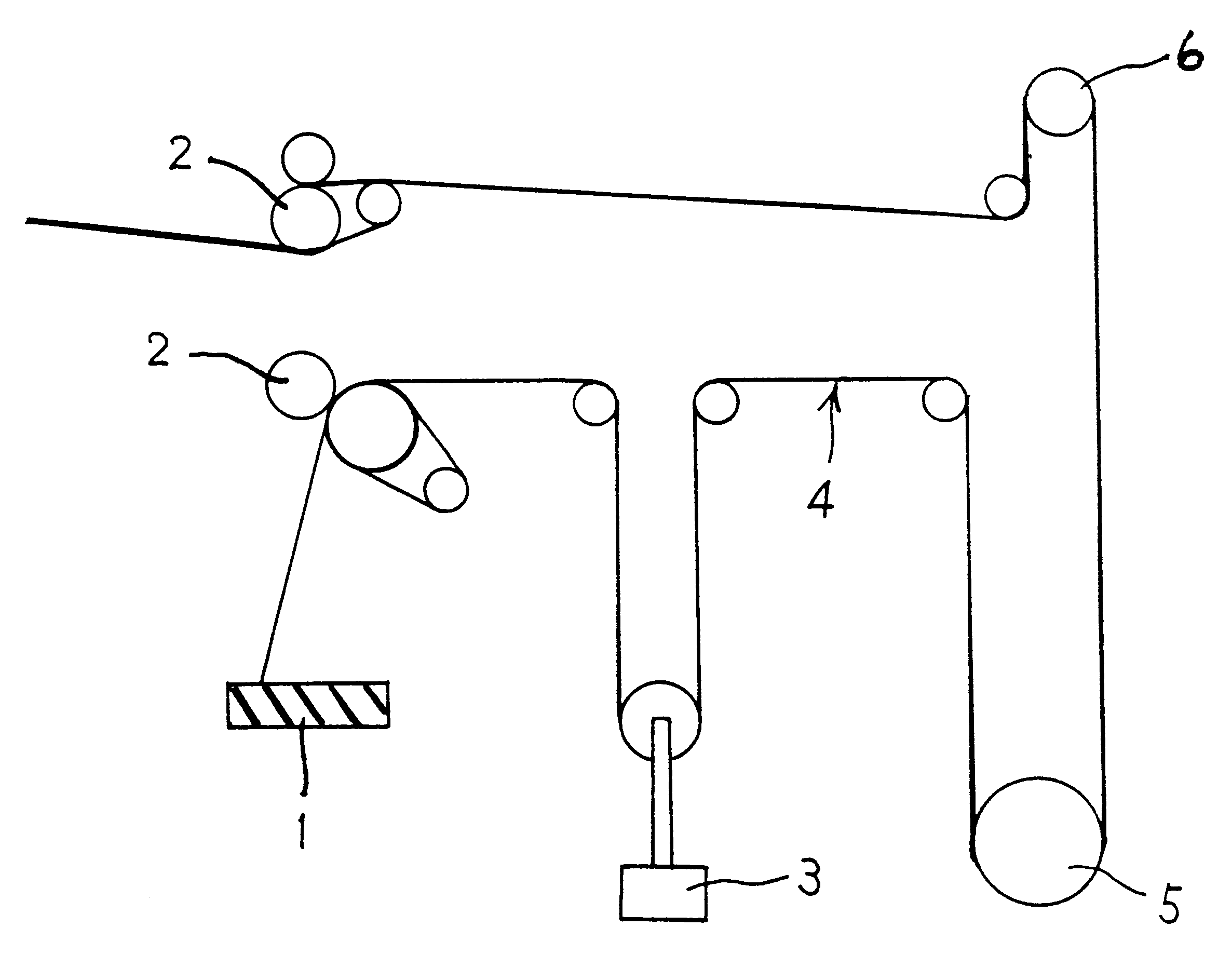Hose reinforcing filament cord
a technology of polyester filament and hose, which is applied in the direction of synthetic resin layered products, transportation and packaging, natural mineral layered products, etc., can solve the problems of lowering productivity, polluting the working environment, and poor adhesiveness of polyester filament yarn, and achieves excellent flexibility, good processing behavior, and high quality properties.
- Summary
- Abstract
- Description
- Claims
- Application Information
AI Technical Summary
Benefits of technology
Problems solved by technology
Method used
Image
Examples
examples
The present invention is described below more concretely in reference to examples. In the following examples, the respective values were measured according to the following methods.
(1) Intrinsic Viscosity (IV)
Eight grams of a sample was dissolved into 100 ml of orthochlorophenol, and the solution was filtered to remove the adhesive. The relative viscosity .eta.r of the filtrate was measured using an Ostwald viscometer at 25.degree. C., and the intrinsic viscosity IV was calculated from the following approximate expression:
IV=0.0242.eta.r+0.2634
(2) Amount of End Carboxyl Groups
Zero point five gram of a sample was dissolved into 10 ml of orthochlorophenol, and the solution was filtered to remove the adhesive. The filtrate was cooled, and 3 ml of chloroform was added. Potentiometry was effected using an NaOH methanol solution, to obtain the amount.
(3) Amounts of Deposited Treating Agents
These were measured according to the dissolving method test of JIS L 1017-1995.
(4) Zeta Potential
An ...
examples 1 to 6
The treating agents used, and the results achieved, appear in Table 3 which follows. In Table 3, CN denotes an orthocresol novolak type polyepoxide; GE represents a glycidyl ether type polyepoxide; and BA represents a bisphenol A type polyepoxide.
As the epoxide treating agent, an orthocresol novolak type polyepoxide water dispersion or a bisphenol A type polyepoxide water dispersion (BA) shown in Table 3 was prepared. It had a solid content 5.0 wt %. The polyepoxide used in Example 3 was an orthocresol novolak type polyepoxide "ECN1400" produced by Asahi-Ciba Limited. In Example 5, a modified bisphenol A type epoxy emulsion "Denacole EX1101" produced by Nagase Chemicals Ltd. was used. In Example 6, a modified bisphenol A type epoxy emulsion "Denacole EX1103" produced by Nagase Chemicals Ltd. was used.
As the (A+B) treating agent, the initial condensation product (A) of resorcin-formaldehyde obtained by reacting 1 mole of resorcin and 2.00 moles of formaldehyde with each other, and a ...
examples 7 to 13
Hose reinforcing filament cords were obtained as described for Example 1, except that the (A+B) treating agent was obtained by mixing at a ratio shown in Table 4, though the first treating agent stated in Example 1 was used as the first treating agent. The expression "2-VP" in Table 3 denotes the 2-vinylpyridine monomer content within the total weight of the latex in the (A+B) treating agent, and the expression "St" denotes the styrene monomer content. The evaluation results of these hose reinforcing filament cords are also shown in Table 4.
As can be seen from Table 4, as for the composition of the second treating agent, when the initial condensation product of resorcin-formaldehyde (A), rubber latex (B) and parachlorophenol-resorcin-formaldehyde co-condensation product (C) were contained at the ratios by solid content weight expressed in the following equations (1) and (2), the effects became remarkable. That is, the resulting cords satisfied all requirements of adhesiveness to chl...
PUM
| Property | Measurement | Unit |
|---|---|---|
| Angle | aaaaa | aaaaa |
| Angle | aaaaa | aaaaa |
| Mass | aaaaa | aaaaa |
Abstract
Description
Claims
Application Information
 Login to View More
Login to View More - R&D
- Intellectual Property
- Life Sciences
- Materials
- Tech Scout
- Unparalleled Data Quality
- Higher Quality Content
- 60% Fewer Hallucinations
Browse by: Latest US Patents, China's latest patents, Technical Efficacy Thesaurus, Application Domain, Technology Topic, Popular Technical Reports.
© 2025 PatSnap. All rights reserved.Legal|Privacy policy|Modern Slavery Act Transparency Statement|Sitemap|About US| Contact US: help@patsnap.com



